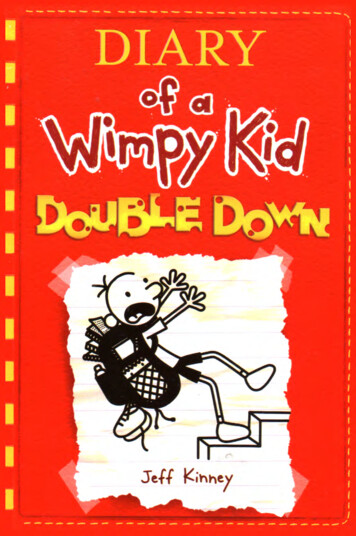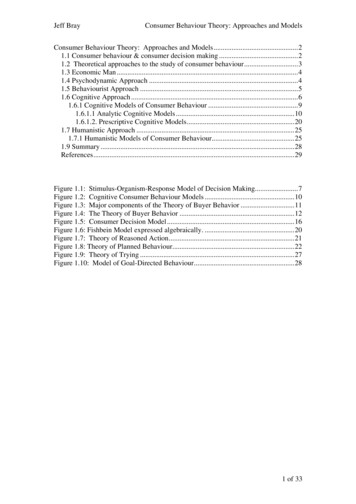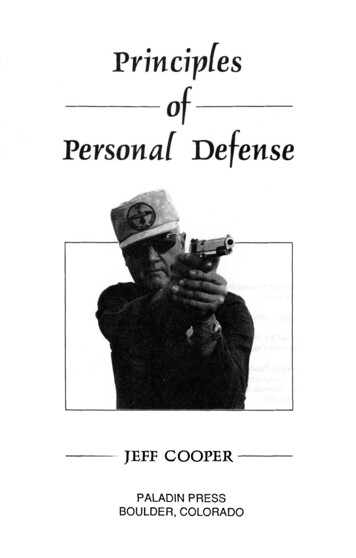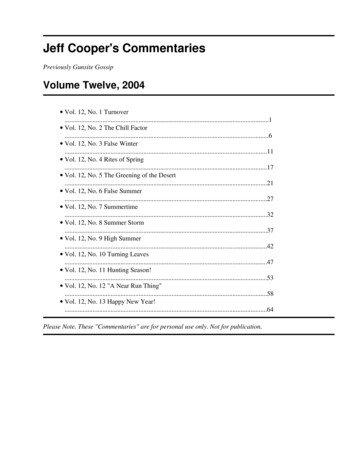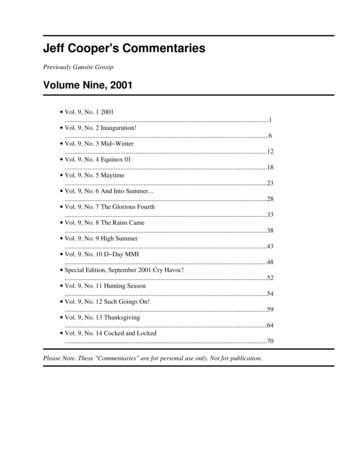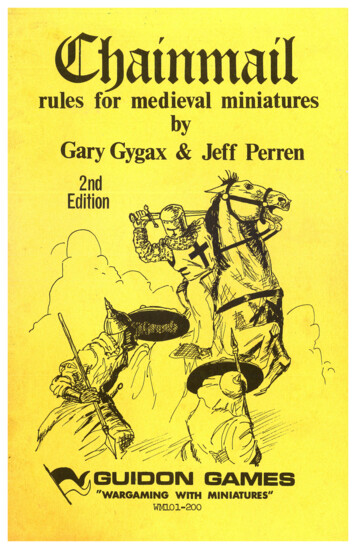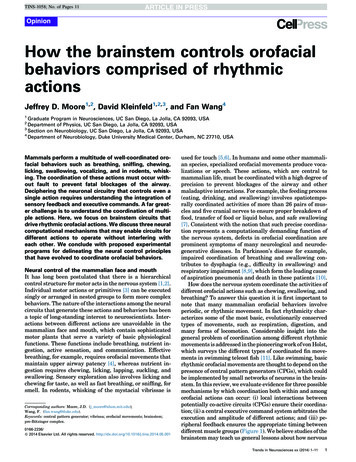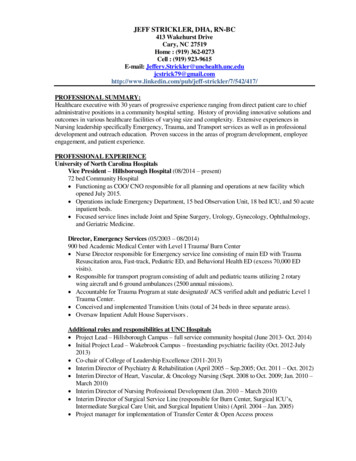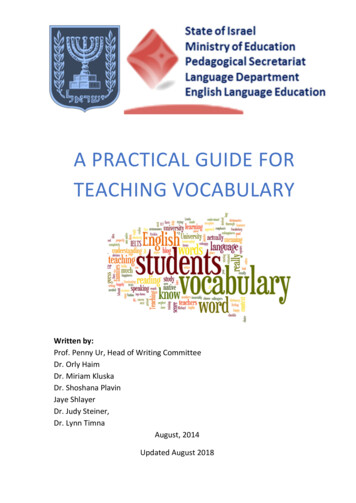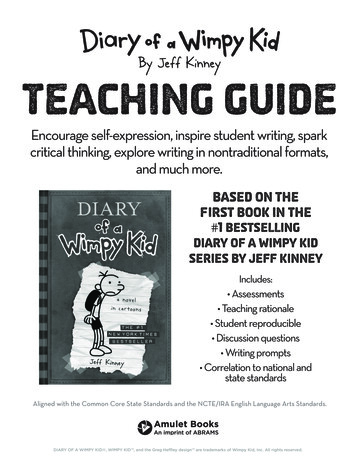
Transcription
By Jeff KinneyTeaching guideEncourage self-expression, inspire student writing, sparkcritical thinking, explore writing in nontraditional formats,and much more.based on thefirst book in the#1 bestsellingdiary of a wimpy kidseries by jeff kinneyIncludes: Assessments Teaching rationale Student reproducible Discussion questions Writing prompts Correlation to national andstate standardsAligned with the Common Core State Standards and the NCTE/IRA English Language Arts Standards.DIARY OF A WIMPY KID , WIMPY KID , and the Greg Heffley design are trademarks of Wimpy Kid, Inc. All rights reserved.1
About the BookThis book is a journal—NOT a diary—belongingto Greg Heffley, a middle school studentstruggling to navigate among the morons, girls,and gorillas that fill his school. Greg figures he’saround the 52nd or 53rd most popular kid thisyear and soon to move up in the ranks.Though this middle school weakling works hardto figure out the angle that will always makethings come out best for him, Greg’s schemesto gain popularity and status rarely seem to payoff. Especially when it comes to dealingswith his best friend Rowley, who has Greg to thank for a broken hand and getting blamed for terrorizing a group ofkindergartners.Throughout his journal, Greg shares all the misadventures of his middle school experience and his family life. Fromwrestling in gym with a weird classmate who shouts “Juice!” when he has to go to the bathroom to being chased byteenagers on Halloween (and losing all his candy when his father douses him with a trash can full of water) to the dailyemptying of his little brother’s plastic potty, Greg acerbically chronicles his year, from the first awkward day of schoolto the last.Diary of a Wimpy Kid is the first book in the Diary of a Wimpy Kid series. First published in 2007, the book has goneon to achieve the status of becoming a #1 international bestseller and has been credited with helping reluctant readersaround the world fall in love with reading. The full Diary of a Wimpy Kid series, which includes nine titles as well as TheWimpy Kid Do-It-Yourself Book and The Wimpy Kid Movie Diary, has more than 150 million books in print worldwide,and has been translated into 45 languages.About the AuthorDiary of a Wimpy Kid author Jeff Kinney was born in 1971 in Maryland and attended the University of Maryland in theearly 1990s. It was there that Jeff ran a comic strip called Igdoof in the campus newspaper, and knew he wanted to be acartoonist.However, Jeff was not successful in getting his comic strip syndicated after college, and in 1998 he started writingdown ideas for Diary of a Wimpy Kid, which he hoped to turn into a book. Jeff worked on the book for six years beforepublishing it online on Funbrain.com in daily installments.In 2006, Jeff signed a multi-book deal with publisher Harry N. Abrams, Inc. to turn Diary of a Wimpy Kid into a printseries. Diary of a Wimpy Kid was released in April 2007 and quickly became a New York Times bestseller a few monthslater. In 2009, Jeff was named one of Time magazine’s 100 Most Influential People in the world.In 2007, Jeff also created Poptropica.com, where he continues to work full time as the creative and editorial director.Jeff lives in southern Massachusetts, where he is opening a bookstore.Table of ContentsWhy Use This Book in Your Classroom2Reading Diary of a Wimpy Kid in Your Classroom2Discussion Questions5Activities6Reproducible Handouts11Standards Alignments15Differentiated Instructions16Further Resources16DIARY OF A WIMPY KID , WIMPY KID , and the Greg Heffley design are trademarks of Wimpy Kid, Inc. All rights reserved.1
Why Use this Book in Your ClassroomMillions of kids are readers because of this book! Even the most reluctant readers can’t put it down. Finishing Diary ofa Wimpy Kid gives struggling readers a great sense of accomplishment. It is a fun, accessible read that helps you promote reflection and self-expression to students reading at all levels. Kids talk about this book. Reading it gives them a book in common with kids in their class, community, and around theworld. It sparks conversations about books and reading. It gives you a springboard to connect students to other titles in the series, in the genre and beyond. Kids see themselves in the book and discuss issues that affect their daily lives. It helps you initiate critical conversations where students critique text and images and question the status quo. Kids love to laugh! And while they’re reading carefully so they don’t miss a single joke, they’ll also be thinking abouthow language, writing, and images communicate ideas. Diary of a Wimpy Kid in your classroom is a great way to meet standards and laugh with your students at the sametime. There are tons of resources to help you! In addition to this Diary of a Wimpy Kid teaching guide, you can also find ateaching guide for the entire series, a teaching guide for the Diary of a Wimpy Kid movies and The Wimpy Kid MovieDiary, as well as activity packets, party kits, and event guides. All these resources and more can be downloaded fromwimpykid.com/wimpykidmonth.Reading Diary of a Wimpy Kid in Your ClassroomGiven the popularity of Diary of a Wimpy Kid, it’s likely many of your students are already familiar with the book and/or the films. To accommodate first-time readers and those acquainted with the book, consider these approaches forreading in the classroom. If these are new approaches for your students, introduce and explain the approach in detailbefore getting started. Read Aloud/Think AloudWhether students have read it or not, having you read Diary of a Wimpy Kid aloud will give them a new experience!Having you “think aloud” will give students insights into how to stop, think, and listen to their own thoughts as theyread.First, read the book yourself and plan your “think aloud.” Experiment with how and where to demonstrate yourreading thought processes and comprehension strategies when you read aloud to students. Then, preview the bookwith your students. Set a purpose for reading and talk about why you chose to read Diary of a Wimpy Kid.And finally, with lots of expression, read! Read the first few entries for “September” aloud to your students. If youhave a camera in your classroom, use it to share the illustrations with your listeners as you read.DIARY OF A WIMPY KID , WIMPY KID , and the Greg Heffley design are trademarks of Wimpy Kid, Inc. All rights reserved.2
As you read aloud, stop and “think aloud,” modeling somegeneral reading strategies that will help all your studentsengage with the book. Share with students the kinds ofquestions you ask yourself that help you get meaning fromboth the text and from the images. In passages studentsmight find confusing, model how you use context clues tounderstand unfamiliar words, re-read unusual expressions,etc. Also “think aloud” at passages and pictures that causeyou to laugh, pause and question or reflect.If students continue reading the book independently,encourage students to use the strategies you just modeled (orany others you feel your students most need) to help themmonitor their understanding and make connections. Alongwith their questions and conclusions, you might have themnote any strategies they use in a Response Journal.If you choose to read the entire book aloud, you cancontinue to “think aloud” when you feel it is appropriate.Most important, model reading flow and really engage yourlisteners! buddy readingReading pairs could include sets of independent readers who read along together or student partners who take turnsreading aloud to each other. Pairs can have the same reading ability or you can couple a more fluent reader with aless fluent reader.Reading buddies should each have their own copy of Diary of a Wimpy Kid, sticky notes, or a Response Journal.Before reading begins, have student pairs meet to preview the book and note their thoughts about what they thinkthe book is about and whether they’ve read it before. Independent reading pairs should decide how many pagesthey plan to read before meeting again. You should help read-aloud pairs decide if they should each read aloud thesame page of the book, alternate reading aloud passages or pages, read aloud together simultaneously or vary theapproach at each meeting.As pairs meet, they should discuss and questioneach other about: What’s going on in Greg’s life and why theyagree or disagree with how he deals withthe situations he finds himself in. Any similar experiences they’ve had. What other things they think might happento Greg and other characters. Graphic elements of the book they feel arecritical to the story. Their own and their buddy’s readingprocess.After finishing the book, buddies can pick oneof the Activities to complete together or develop their own reading project to share their commonreading experience. Book ClubA book club approach to reading Diary of a Wimpy Kid is perfect for independent readers ready to have authenticconversations about books without assigned literature discussion roles. This means that students need to know howDIARY OF A WIMPY KID , WIMPY KID , and the Greg Heffley design are trademarks of Wimpy Kid, Inc. All rights reserved.3
to come up with open-ended questions to share with their group and already have some experience discussing booksin a less structured but engaging and meaningful way.Before forming groups of four or five students, teach or review strategies for active listening and contributingto discussions with the entire class. Brainstorm ideas about what kinds of things to talk about in a discussion ofliterature and what individuals should do to prepare to participate.At the initial meeting, students should to get to know their book club members, preview the book, negotiate whatpages they need to read by the time the group meets next and determine what preparation is expected for the firstdiscussion.Encourage students to bring their own experiences and perspectives. They should see book club as an opportunityto share their personal responses to the book and the issues addressed in it, like friendship, popularity, bullying, andself-identity.Because book clubs are reader response centered, having students keep a Response Journal will help supportstudent responsibility and ownership of the book club. Students can use their journal notes, drawings, observations,and questions as a jumping-off point for discussions.Give students the chance to steer their own discussions, but if they need prompting, Discussion Questions in thisguide can help foster and support discussion. After finishing the book, have students compile the best of their owndiscussion questions and organize them as a discussion guide to share with future book clubs. Response JournalDiscuss diary and journal writing with the class. Have students offertheir ideas about what distinguishes journals, diaries, and blogs.Ask them to share works they’ve read or know of in this genre. Askstudents to offer reasons why they or others write down their privatethoughts, how this exercise can benefit the writer and how it canaffect readers.Tell students they will be keeping a response journal while readingDiary of a Wimpy Kid. Students will use their journals for asking andanswering questions, noting passages or phrases of interest, makingpredictions and analysis, and for reflecting and relating what theyhave read to their own lives. Students should plan to draw from theirjournals during book discussions.Students may take a cue from Greg and keep their response journal in the same format as his diary. And hopefullythey’ll also be as descriptive and direct! But remind them that there’s no single right way to respond to a book, soencourage equally varied methods of response, including writing, drawing, mapping, and charting. Work with yourstudents to generate prompts to ensure their responses allow them to make a personal connection to the book andtake ownership of what they’ve read.DIARY OF A WIMPY KID , WIMPY KID , and the Greg Heffley design are trademarks of Wimpy Kid, Inc. All rights reserved.4
Discussion QuestionsThe questions below can be used for class or small group discussion or offered to students as reflective writingprompts. For meaningful discussion, as students read they should note ideas they find interesting or that make themwonder, passages they don’t understand, phrases or passages that they like, and things they question, predict, andconclude. Students can also use their notes to develop their own questions for discussion. Diary of a Wimpy Kid is subtitled “a novel in cartoons.” How do the cartoons affect the story? Besides the cartoons, inwhat ways do you think the book is different from other novels you have read? With the title Diary of a Wimpy Kid, what do you think the author is trying to tell you about Greg Heffley? How wouldyou define wimpy? What characteristics and behaviors do you associate with Greg? What characteristics and behaviors do you wantpeople to associate with you? Why? Greg writes “I’ll be famous one day, but for now I’m stuck in middle school with a bunch of morons.” Describe whatyou imagine Greg thinks he’s going to be famous for. Do you agree or disagree with Greg’s opinions about what makes someone popular? Why or why not? How canpopularity affect someone’s behavior? What are the characteristics of a good friend? How do you think Rowley feels about his friendship with Greg? IfRowley kept a journal how would he describe his interactions with Greg? Describe Greg’s relationship with his family. How is your relationship with your parents or your siblings similar ordifferent? Greg’s brother, Manny, calls Greg “Bubby.” Describe how Greg feels about this nickname. Does someone in yourfamily have a nickname for you? What is it and how did the name come about? How do you feel when you are calledby this name? Do you think this book is funny? Why or why not? Discuss a part of t
Wimpy Kid Do-It-Yourself Book and The Wimpy Kid Movie Diary, has more than 150 million books in print worldwide, and has been translated into 45 languages. About the Author Diary of a Wimpy Kid author Jeff Kinney was born in 1971 in Maryland and attended the University of Maryland in the early 1990s. It was there that Jeff ran a comic strip called Igdoof in the campus newspaper, and knew he .
